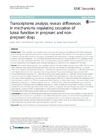Transcriptome analysis reveals differences in mechanisms regulating cessation of luteal function in pregnant and non-pregnant dogs
dc.contributor.author
Zatta, Sophie
dc.contributor.author
Rehrauer, Hubert
dc.contributor.author
Gram, Aykut
dc.contributor.author
Boos, Alois
dc.contributor.author
Kowalewski, Mariusz P.
dc.date.accessioned
2017-12-19T15:47:40Z
dc.date.available
2017-10-19T02:06:48Z
dc.date.available
2017-12-19T15:47:40Z
dc.date.issued
2017
dc.identifier.issn
1471-2164
dc.identifier.other
10.1186/s12864-017-4084-9
en_US
dc.identifier.uri
http://hdl.handle.net/20.500.11850/197680
dc.identifier.doi
10.3929/ethz-b-000197680
dc.description.abstract
Background
In the domestic dog, corpora lutea (CL) are the only source of progesterone (P4), both in pregnant and non-pregnant cycles because there is no placental steroidogenesis. The absence of an endogenous luteolysin in absence of pregnancy results in long-lasting physiological pseudopregnancy, strongly contrasting with the acute luteolysis observed prepartum. The underlying biological mechanisms and the involvement of P4 signalling remain, however, not fully understood. Therefore, here, next-generation sequencing (RNA-Seq) was performed on CL from the late luteal phase and compared with normally luteolyzing CL collected at the prepartum P4 decrease.
Results
The contrast “luteal regression over luteolysis” yielded 1595 differentially expressed genes (DEG). The CL in late luteal regression were predominantly associated with functional terms linked to extracellular matrix (p = 5.52e-05). Other terms related to transcriptional activity (p = 2.45e-04), and steroid hormone signalling (p = 2.29e-04), which were more highly represented in late regression than during luteolysis. The prepartum luteolysis was associated with immune inflammatory responses (p = 2.87e-14), including acute-phase reaction (p = 4.10e-06). Immune system-related events were also more highly represented in CL derived from normal luteolysis (p = 7.02e-04), compared with those from dogs in which luteolysis was induced with an antigestagen (1480 DEG in total). Additionally, the withdrawal of P4 at mid-gestation resulted in 92 DEG; over-represented terms enriched in antigestagen-treated dogs were related to the inflammatory response (p = 0.005) or response to IL1 (p = 7.29e-05). Terms related to proliferation, e.g., centrosome organization (p = 0.002) and steroid metabolic processes (p = 0.001), prevailed at mid-gestation. Thereby, our results revealed the nature of luteotropic effects of P4 within canine CL. It appears that, even though they result in diminished steroidogenic output, the effect of antigestagens is more related to the withdrawal of P4 support than to the PGF2alpha-related inflammatory reaction observed at physiological parturition.
Conclusions
We report the differential gene expression associated with maintenance and cessation of luteal function in pregnant and non-pregnant dogs. Based on the differentially expressed genes, we indicate functional pathways and gene networks that are potentially involved in the underlying endocrine and molecular mechanisms. This study establishes future research directions that may be helpful in understanding some of the clinical conditions, such as luteal insufficiency, associated with negative pregnancy outcome in dogs.
en_US
dc.format
application/pdf
dc.language.iso
en
en_US
dc.publisher
BioMed Central
en_US
dc.rights.uri
http://creativecommons.org/licenses/by/4.0/
dc.subject
Dog (Canis familiaris)
en_US
dc.subject
CL
en_US
dc.subject
Luteal regression
en_US
dc.subject
Prepartum luteolysis
en_US
dc.subject
Induced abortion
en_US
dc.title
Transcriptome analysis reveals differences in mechanisms regulating cessation of luteal function in pregnant and non-pregnant dogs
en_US
dc.type
Journal Article
dc.rights.license
Creative Commons Attribution 4.0 International
dc.date.published
2017-09-27
ethz.journal.title
BMC Genomics
ethz.journal.volume
18
en_US
ethz.journal.issue
1
en_US
ethz.journal.abbreviated
BMC Genomics
ethz.pages.start
757
en_US
ethz.size
18 p.
en_US
ethz.version.deposit
publishedVersion
en_US
ethz.identifier.wos
ethz.identifier.scopus
ethz.publication.place
London
en_US
ethz.publication.status
published
en_US
ethz.leitzahl
ETH Zürich::00002 - ETH Zürich::00003 - Schulleitung und Dienste::00022 - Bereich VP Forschung / Domain VP Research::02207 - Functional Genomics Center Zurich / Functional Genomics Center Zurich
ethz.leitzahl.certified
ETH Zürich::00002 - ETH Zürich::00003 - Schulleitung und Dienste::00022 - Bereich VP Forschung / Domain VP Research::02207 - Functional Genomics Center Zurich / Functional Genomics Center Zurich
ethz.date.deposited
2017-10-19T02:06:54Z
ethz.source
SCOPUS
ethz.eth
yes
en_US
ethz.availability
Open access
en_US
ethz.rosetta.installDate
2017-12-19T15:47:47Z
ethz.rosetta.lastUpdated
2024-02-02T03:33:15Z
ethz.rosetta.versionExported
true
ethz.COinS
ctx_ver=Z39.88-2004&rft_val_fmt=info:ofi/fmt:kev:mtx:journal&rft.atitle=Transcriptome%20analysis%20reveals%20differences%20in%20mechanisms%20regulating%20cessation%20of%20luteal%20function%20in%20pregnant%20and%20non-pregnant%20dogs&rft.jtitle=BMC%20Genomics&rft.date=2017&rft.volume=18&rft.issue=1&rft.spage=757&rft.issn=1471-2164&rft.au=Zatta,%20Sophie&Rehrauer,%20Hubert&Gram,%20Aykut&Boos,%20Alois&Kowalewski,%20Mariusz%20P.&rft.genre=article&rft_id=info:doi/10.1186/s12864-017-4084-9&
Files in this item
Publication type
-
Journal Article [128949]

